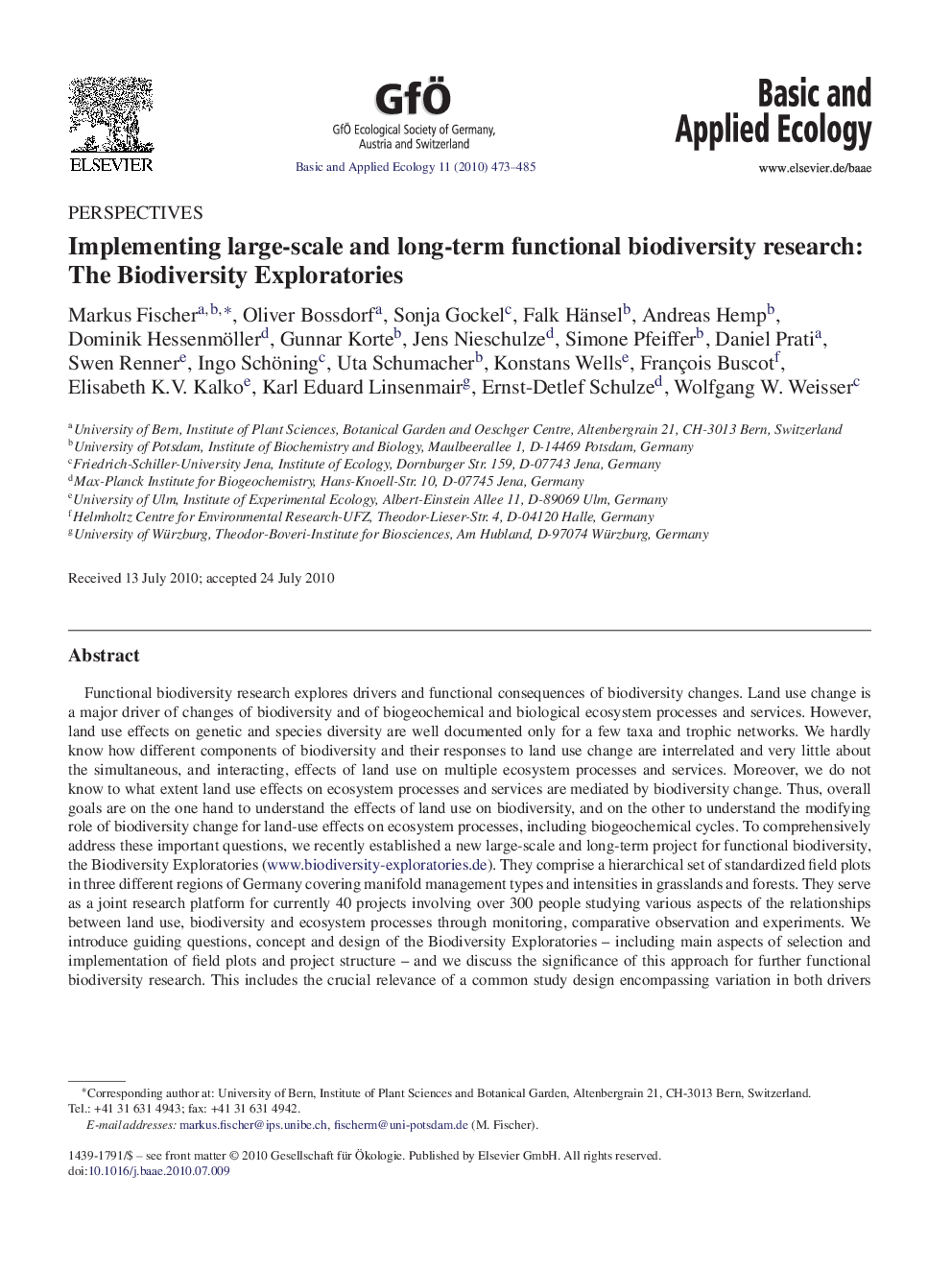| Article ID | Journal | Published Year | Pages | File Type |
|---|---|---|---|---|
| 4384288 | Basic and Applied Ecology | 2010 | 13 Pages |
Functional biodiversity research explores drivers and functional consequences of biodiversity changes. Land use change is a major driver of changes of biodiversity and of biogeochemical and biological ecosystem processes and services. However, land use effects on genetic and species diversity are well documented only for a few taxa and trophic networks. We hardly know how different components of biodiversity and their responses to land use change are interrelated and very little about the simultaneous, and interacting, effects of land use on multiple ecosystem processes and services. Moreover, we do not know to what extent land use effects on ecosystem processes and services are mediated by biodiversity change. Thus, overall goals are on the one hand to understand the effects of land use on biodiversity, and on the other to understand the modifying role of biodiversity change for land-use effects on ecosystem processes, including biogeochemical cycles. To comprehensively address these important questions, we recently established a new large-scale and long-term project for functional biodiversity, the Biodiversity Exploratories (www.biodiversity-exploratories.de). They comprise a hierarchical set of standardized field plots in three different regions of Germany covering manifold management types and intensities in grasslands and forests. They serve as a joint research platform for currently 40 projects involving over 300 people studying various aspects of the relationships between land use, biodiversity and ecosystem processes through monitoring, comparative observation and experiments. We introduce guiding questions, concept and design of the Biodiversity Exploratories – including main aspects of selection and implementation of field plots and project structure – and we discuss the significance of this approach for further functional biodiversity research. This includes the crucial relevance of a common study design encompassing variation in both drivers and outcomes of biodiversity change and ecosystem processes, the interdisciplinary integration of biodiversity and ecosystem researchers, the training of a new generation of integrative biodiversity researchers, and the stimulation of functional biodiversity research in real landscape contexts, in Germany and elsewhere.
ZusammenfassungFunktionelle Biodiversitätsforschung erforscht die Ursachen und funktionellen Konsequenzen von Biodiversitätsveränderungen. Landnutzung gehört zu den wichtigsten Ursachen von Änderungen von Biodiversität und biogeochemischen und biologischen Ökosystemprozessen und -leistungen. Allerdings sind Landnutzungsauswirkungen auf genetische und Artendiversität bisher nur für wenige Taxa und trophische Netzwerke gut dokumentiert. Zudem ist kaum bekannt, wie verschiedene Komponenten der Biodiversität und ihre Reaktion auf Landnutzungsänderungen zusammenhängen. Auch ist wenig über gleichzeitige und miteinander wechselwirkende Effekte der Landnutzung auf mehrere verschiedene Ökosystemprozesse und -leistungen bekannt. So ist auch noch unklar, inwieweit Landnutzungseffekte auf Ökosystemprozesse und -leistungen durch Biodiversitätsveränderungen vermittelt werden. Es gilt also einerseits Landnutzungseffekte auf Biodiversität zu verstehen und andererseits die modifizierende Rolle von Biodiversitätsveränderungen für Landnutzungseffekte auf Ökosystemprozesse, einschliesslich biogeochemischer Kreisläufe. Um diese wichtigen Fragen umfassend zu untersuchen, haben wir kürzlich ein grosses und langfristiges Projekt zur funktionellen Biodiversitätsforschung gestartet, die Biodiversitäts-Exploratorien (www.biodiversity-exploratories.de). Diese umfassen einen Satz standardisierter Untersuchungsflächen in drei Regionen Deutschlands, die jeweils vielfältige Typen und Intensitäten der Wald- und Grünlandnutzung umfassen. Sie dienen als gemeinsame Forschungsplattform für gegenwärtig 40 Projekte mit über 300 Beteiligten, die verschiedenste Aspekte der Beziehung zwischen Landnutzung, Biodiversität und Ökosystemprozessen durch Monitoring, vergleichende Beobachtung und Experimente untersuchen. Wir stellen Leitfragen, Konzept und Design der Biodiversitätsexploratorien vor – einschliesslich der wesentlichen Aspekte der Auswahl und Einrichtung der Untersuchungsflächen und der Projektstruktur – und wir diskutieren die Bedeutung des Ansatzes für die weitere funktionelle Biodiversitätsforschung. Diese beinhaltet die zentrale Bedeutung des gemeinsamen Forschungsdesigns, das sowohl Ursachen als auch Konsequenzen der Veränderungen von Biodiversität und Ökosystemprozessen umfasst, die interdisziplinäre Integration von Biodiversitäts- und Ökosystemforschenden, die Ausbildung einer neuen Generation von integrativen Biodiversitätsforschern und die Anregung funktioneller Biodiversitätsforschung im realen Landschaftskontext, in Deutschland und darüber hinaus.
